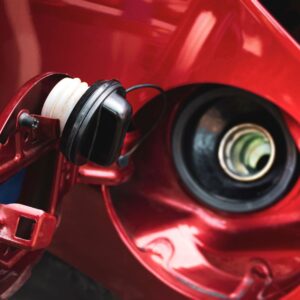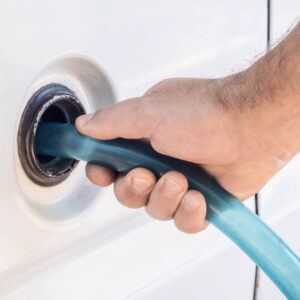There’s a myth that you can put sugar in someone else’s gas tank and ruin their car. This stems from the understanding that the sugar will dissolve in the fuel. Then, once the sugar-filled fuel is sucked into the engine, the heat will cause the sugar to caramelize, which will damage the engine. This idea stemmed from the 1950s when vandals used sugar to make engines malfunction. However, sugar simply clogged the mechanical fuel pumps at the bottom of the fuel tank, which stopped fuel from flowing to the engine.
What Happens If You Put Sugar In a Gas Tank
Sugar molecules can’t dissolve in gasoline because they have different molecular polarities. Sugar will just sink to the bottom of the fuel tank.
All the sugar won’t automatically get sucked into the fuel pump because the fuel sending unit pulls fuel through a small straw-like funnel rather than a drain-like hole. If there’s any sugar that gets sucked in, most vehicles are equipped with a fuel filter designed to remove impurities up to 10 microns in size. The filter can easily filter out tabletop sugar since they’re usually around 100 to 400 microns in size.
However, confectioner’s sugar is only about 10 microns per granule, so it would be able to pass through the fuel filter and clog the injectors, much the way rust particles will if they make their way into the fuel tank from an outside source, like a rusty gas storage tank.
The fuel tank pickup screen is a 40 micron screen, so it’s not likely that regular tabletop sugar can even make it into the fuel pump, let alone into the frame mounted fuel filter. Besides that, any tabletop sugar that does get past the in-tank fuel pickup screen would lock the pump up.
But again, confectioner’s sugar is small enough to make it all the way to the injectors and may even pass through some of the injectors on higher performance cars that are designed to deliver more fuel and have slightly larger openings. If that happens, there may be some caramelization after all!
Problems can stem from sugar clogging the filter. At the same time, there’s a chance some sugar can get past the filter and clog the vehicle’s fuel injectors, but tabletop sugar will only pass the fuel filter if its element is damaged somehow so that those large sugar granules can pass through the filter, which isn’t likely.
The symptoms of sugar in a gas tank include:
- Stalling
- Poor acceleration
- Power surges
- No start condition
Modern vehicles use electric fuel pumps, which aren’t as prone to clogging. However, these pumps can still get clogged if there’s a lot of sugar.

Sugar in your vehicle’s fuel tank won’t cause extensive engine damage unless it’s confectioner’s sugar or some kind of pancake syrup, but the fuel system and fuel injectors can develop issues.
How to Fix Sugar In Gas Tank
This process involves dropping your vehicle’s fuel tank, cleaning it, and replacing the fuel filter.
Raise the Vehicle
Raise the vehicle with a jack and mount the car on some jack stands. Ensure the battery is unplugged to eliminate the risk of sparks, which can ignite fuel vapors and cause a fire.
Drain the Fuel Tank
Drain the fuel tank if at all possible, because it’s heavy when it has a lot of fuel in it and you will drop it if it’s not supported.
Access the Fuel Tank
Check your vehicle’s owner’s manual for information on accessing your vehicle’s fuel tank. On a sedan, the top of the fuel tank can be accessed by removing the rear passenger seats. You’ll see a lid, which can be removed with some screws.
You’ll be able to see the fuel pump on top of the fuel tank if your vehicle has an access cover (look it up if you’re not sure). Some vehicles have an access cover in the trunk up under the package tray (Buick LaCrosse 200x models are built this way).
Disconnect the Fuel Filler Hose
The fuel filler hose is a plastic tube with a special type connection to the fuel pump output that may require a special tool. Many fuel pumps also have a return line. These lines, and, in many cases, the fuel tank pressure sensor are connected to the fuel pump plate that is usually in the top of the tank (except on Crown Victorias, where it’s on the front of the vertically mounted tank).
The fuel sending unit connector, FTP sensor connector, and evaporative system tubes must also be disconnected. The evap tube lines are usually connected in other places to the top of the tank apart from the fuel pump. There may be more than one. If you fail to disconnect every tube and lower the tank with it connected so that you break one of the plastic nipples and it’s part of the tank, you’ll have to replace the tank.
Disconnect the Filler Tube Hose and Remove Fuel Tank Straps
The filler tube connects with a clamp and may be difficult to access, but it has to be connected in order to remove the tank. Sometimes you can unbolt the filler neck from the car body and lower it all together, but this is not always feasible due to the length of the filler tube and the fact that it passes over the top of the frame on ladder frame vehicles.
The fuel tank is strapped to the vehicle’s chassis cross members or car body, usually with bolts that are passing through flag nuts in the crossmembers.
After disconnecting everything and removing the straps, the fuel tank just drops down. Again, be careful if the fuel tank is full of fuel, as it can be quite heavy.
Remove the Fuel Pump
You can’t gain access to the inside of the tank without removing the fuel pump. Don’t use anything with a flame to look into the tank or you’ll risk an explosion. Don’t use an incandescent drop light; always use a flashlight or and LED drop light.
Drain the Fuel Tank
Do this by tilting the fuel tank and draining the fuel into a bucket. Afterward, use a towel to soak up the remaining fuel.
Rinse the Tank
You’ll need to use a pressure washer (think car wash) to get the sugar out of the tank, because it will be settled in places where the gas won’t wash it out. This could take some time. If done correctly, this will remove all the sugar granules in the fuel tank since sugar will dissolve in water. Dry the fuel tank afterward with the towel.
Flush the Fuel Line
To clean this out, just use a hose to flush out any lines suspected of having sugar in them. Don’t be afraid to use a lot of water, then flush with denatured alcohol (you can buy this at places that sell paint). Any water in the tube will mix with the alcohol and cause it to evaporate quickly.
Replace the Fuel Filter and Pump Assembly
Replacing the fuel filter on some vehicles isn’t possible because their fuel filters are integrated with the fuel pump assembly. When this is the case, you’ll need to replace the entire fuel pump assembly. Some manufacturers recommend replacing the entire fuel pump assembly whenever the tank is contaminated.
Clean the Fuel Lines and Fuel Rail
Disconnect the fuel rail and fuel lines from the engine using a wrench. Once removed, use compressed air to blow the fuel line on the engine side. This will push the contaminated gasoline out the other end. Pour the fuel line with isopropyl alcohol to rinse it, then use pressurized air to push all the alcohol out. Do the same process for the fuel rail.
Any information provided on this Website is for informational purposes only and is not intended to replace consultation with a professional mechanic. The accuracy and timeliness of the information may change from the time of publication.




































